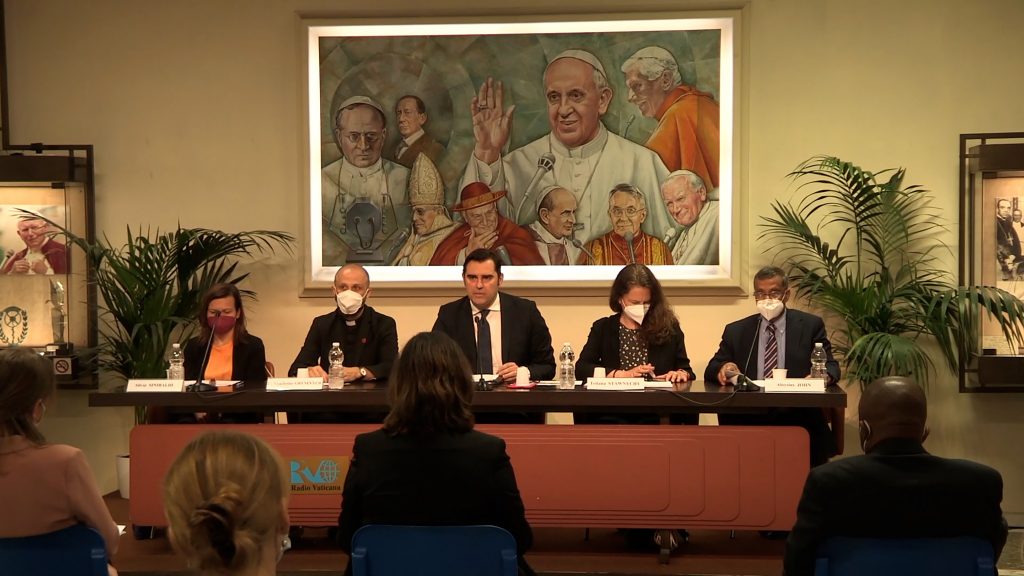ROME — In the Catholic galaxy, some individuals and groups are more “ad intra,” meaning focused on the internal life of the Church, while others tend to have a largely “ad extra” focus, meaning engaged with the outside world.
On that spectrum, few ecclesiastical realities generally are more “ad extra” than Catholic charities, and that’s for a variety of reasons.
First, when you’re dealing with the world’s most galling conflicts, its most horrific acts of violence, and its most devastating natural disasters — the war in Ukraine, for instance, or the recent mass shootings in the U.S., or the landslides on the Italian island of Ischia — many “ad intra” Catholic debates may well strike you as akin to debating how many angels can dance on the head of a pin.
When you’re trying to save people from hunger, violence, trafficking, and abuse, rather than how widespread permission for the Latin Mass ought to be, or who ought to be ordained a deacon, probably doesn’t seem all that pressing.
Second, for most Catholic charitable workers, their natural conversation partners aren’t ecclesiastical types in chanceries or Vatican offices, but rather personnel from other organizations trying to meet the same needs. People from the Red Cross, or the U.N., or Doctors Without Borders, are probably far more familiar to most officials in Catholic charities than monsignors and bishops.
Third, the bulk of the funding for most Catholic charities doesn’t come from the Church.. Naturally, therefore, the focus among many Catholic charitable groups tends to be more on the expectations of the people paying the bills rather than notional ecclesiastical overseers.
Yet the truth of the matter is that however autonomous a Catholic charitable group may believe itself to be, Church authorities — especially popes — can always find ways of reminding them who’s actually in charge.
That’s a point with special relevance right now for Caritas Internationalis, a global federation of roughly 162 Catholic charitable organizations around the world, among them Catholic Charities USA, the domestic relief arm of the U.S. bishops. Active in more than 200 countries, its headquarters is on Vatican territory in Rome’s Piazza San Calisto.
For the second time in a little over a decade, a pope has effectively placed Caritas into receivership, removing its leadership and ordering an overhaul of the organization’s rules. Such a takeover happened under Pope Benedict XVI, and it happened again under Pope Francis on Nov. 22, though admittedly for very different reasons.
In 2011, the Vatican blocked the reappointment of British laywoman Lesley-Anne Knight as secretary general of Caritas, effectively the CEO, in part over concerns that Caritas was partnering with organizations that promoted “family planning” such as birth control and abortion, and otherwise had priorities not fully in keeping with Catholic teaching.
The tensions over Knight led to a new set of statutes clarifying the Vatican’s oversight role with regard to Caritas, among other things emphasizing the authority of the Secretariat of State as well as the Pontifical Council Cor Unum (the latter was suppressed as part of Pope Francis’ Vatican reform in 2016).
This time around, the concerns don’t seem as much doctrinal as managerial and administrative, though the results are more or less the same.
In one fell swoop, Pope Francis fired the entire leadership team at Caritas last Tuesday and appointed his own interim administrator, Italian organizational consultant Pier Francesco Pinelli, who will run things ahead of the next general assembly of Caritas set for May 2023.
The Vatican didn’t really offer much explanation for the move, beyond insisting that it had nothing to do with either sexual abuse or financial impropriety. Instead, a statement said that an internal review had revealed “real deficiencies” in management, leading to damage to “team-spirit and staff morale.”
On background, sources inside Caritas say the perceived problems likely center around Aloysius John, an Indian layman with French citizenship who took over as secretary general in 2019, and who’s been accused of heavy-handed leadership and suspect management.
Some Caritas personnel seemed to welcome the papal initiative, though the sentiment is by no means universal. Also on background, a former senior official at Caritas described the move as “incomprehensible,” a “coup,” and “totally the opposite of the synodal path” called for by Pope Francis, which supposedly prioritizes consultation and shared decision-making rather than papal fiat.
Many observers also took the move as a blow to Filipino Cardinal Luis Antonio “Chito” Tagle, who had been the elected president of Caritas since 2015, and who’s now also demoted. Heretofore seen as a stalwart papal ally, it’s now not entirely clear whether Cardinal Tagle still enjoys the pontiff’s favor.
In any event, there’s one ineluctable lesson from the most recent papal takeover, which, if this were a Hollywood movie, might well be called “Caritas II: Crackdown Harder.” The lesson is this, in the words of the late great American Father Robert Taft, SJ: “If you want to swim in the Catholic pool, sooner or later you have to make your peace with the lifeguard.”
Officials in Catholic charities, in other words, would do well to cultivate good relations with bishops and other Church leaders right out of the gate, rather than trying to defuse the bomb after it’s already gone off.
In that sense, there’s now sort of a “Caritas Rule” for charitable groups in the Catholic sphere: Never forget that if they want to, popes and other Church potentates can make your life really, really difficult — so, to the extent possible, try not to give them a reason to do so.

